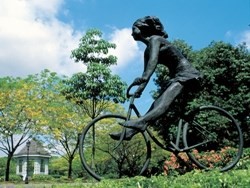Singapore is greenest city in Asia
-
15 February 2011
In the next few decades, what we have seen in the developed world will take place in Asia as urbanisation gathers momentum across China, India and Southeast Asia.
This article has been migrated from an earlier version of the site and may display formatting inconsistencies.

Click here to read further.
SPEECH BY DR AMY KHOR, MAYOR OF SOUTH WEST DISTRICT, AT THE OFFICIAL LAUNCH OF SIEMENS' ASIAN GREEN CITY INDEX , 14 FEBRUARY 2011, 10:00 AM AT THE CONRAD CENTENNIAL HOTEL
Ms Barbara Kux, Siemens Chief Sustainability Officer and Managing Board Member, Siemens AG
Distinguished Guests
Ladies and Gentlemen
Good Morning,
I am very honoured to be here today to receive this distinguished award on behalf of Singapore. I would like to thank the organizers, Siemens, the Economist Intelligence Unit (EIU) and the Centre for Liveable Cities (CLC), for their efforts in documenting the best practices in environmental management by Asian cities through this study.
2 Half the world's population already lives in cities. In the next few decades, what we have seen in the developed world will take place in Asia as urbanisation gathers momentum across China, India and Southeast Asia. Rapid urbanisation will pose new opportunities and challenges. One common challenge is to achieve a good balance between economic growth and environmental sustainability. While the two are often seen to be mutually exclusive, the reality is that we need to achieve both concurrently. No growth can be sustainable if we neglect the environment; neither can there be environmental sustainability without economic growth.
3 As you are aware, Singapore is a city with limited natural resources and land space. Since the early days of our nation-building, careful thought has been put into how we manage our scarce resources and achieve economic growth, while maintaining a good quality living environment for our people. Today, Singapore enjoys a reputation as a clean and green garden city, through long-term planning and an integrated approach to urban management. Where we encountered constraints, such as our shortage of water, we turned this into an opportunity and developed NEWater. Likewise, we treat waste as a resource and convert waste into energy. This culture of continuous innovation underpins much of Singapore's efforts to overcome its constraints. Our reputation as a clean and green city is the result of continuous effort and cooperation from all stakeholders from the government, industry and community.
4 Going forward, we cannot rest on our laurels. We live in a more resource constrained world. Higher energy prices, climate change and rising raw material prices all mean that we have to be more prudent with our use of resources. In 2008, the CLC was established by the government to harness urban developmental experiences across the public, private and people sectors, in order to position Singapore as an innovative thought-centre in integrated urban solutions for high-density urban living, liveability and sustainable development. The following year, the government drew up the Sustainable Singapore Blueprint - a master-plan that charts Singapore's national strategy on sustainable development. The Blueprint seeks to improve resource efficiency; enhance the physical environment through controlling pollution, increase green spaces and clean up major water sources; encourage residents to adopt a more environmentally responsible lifestyle; and develop technologies to help balance growth with sustainability. The Blueprint included proposals to improve environmental education in schools, fund partnerships with environmental NGOs, and a pledge to implement ideas from the public and business community to improve environmental sustainability. We hope the Blueprint will take us a leap forward in realising our vision to transform Singapore into a liveable and lively city state.
5 Beyond the government initiatives, policies, legislation and the infrastructure, the support of the community itself - fostering community action or citizen engagement - is vital to building a sustainable economy and environment. Furthermore, liveable communities are not just about their physical attributes but also about cohesiveness, sense of ownership, volunteerism, self help and other attributes of the society. Hence, organisations and forms of local government that operate at the grassroots and community levels play a hugely important role to make environmental sustainability and liveability part of the Singapore DNA. One such organisation is the Community Development Council (CDC).
6 There are five (5) Community Development Councils (CDCs) in Singapore, each headed by a Mayor and overseeing the local administration of a district. The South West CDC, of which I am Mayor, rallies its stakeholders and partners to develop sustainability masterplans for their respective districts, which dovetail into the Sustainable Singapore blueprint.
7 I am gratified that the Index has recognised the efforts of the Singapore Government in urban planning, environmental and water management and improving our energy efficiency - our key strategy to mitigate climate change. But there is much that we can learn from other Asian cities like Tokyo, Shanghai and Hanoi whose best practices are highlighted in the index.
8 Singapore's modest achievements in the Asian Green City Index will certainly spur us on to do more, as we play our part as a member of the global community to mitigate the impact of climate change, for present and future generations. I trust that the Index will encourage Asian cities to learn from one another as we strive to address the environmental challenges faced by an increasingly urbanized Asia.
9 Thank you.
